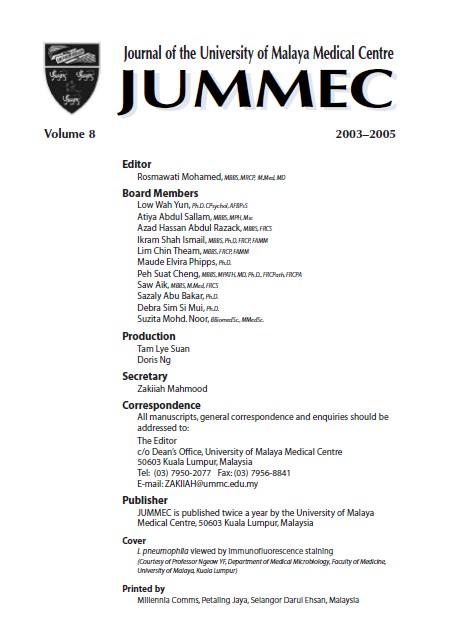TERM BREECH TRIAL AND ITS CONSEQUENCES ON PRACTICE:A RETROSPECTIVE STUDY OF THE UNIVERSITYOF MALAYA MEDICAL CENTRE'S EXPERIENCE
Abstract
To see the trend in managing singleton breech pregnancy after the term
breech trial. Secondly to compare the safety of different modes of delivery for term, singleton breeches by looking at the immediate neonatal outcome, based on our own experience. Breech infants were identified by examining computer-stored maternal discharge records of hospitalization for the years 1990 and 2000 respectively. Parameters
studied included planned mode of delivery, actual mode of delivery, parity, previous vaginal delivery, Apgar score at five minute, birth weight, referral to special care nursery and neonatal morbidity. Of 6,496 deliveries in 1990 and 5,081 in 2000, there were 220 (3.4%) and 148 (2.9%) term breech infants respectively, of which 115 (for 1990) and 102 (for 2000) case records were available. In 1990, 62.6% of the women had trial of vaginal breech delivery but only 24.5% of the women in 2000 were allowed to do so (p < 0.05). Caesarean section rate for singleton breeches increased from 51.3% in 1990 to 84.3% in 2000 (p < 0.05). Mean Apgar score at five minutes was significantly lower after vaginal breech delivery (9.40 ' 1.36) compared to after Caesarean section (9.72 ' 0.712) but there was no clinical significance. There was a noticeable trend towards Caesarean section and less trial of vaginal delivery. Neonatal outcomes of babies born abdominally
were statistically better than those born vaginally but there was little clinical impact. Perhaps in properly selected cases, a planned vaginal breech delivery still has a role to play.
Downloads
Downloads
Published
Issue
Section
License
All authors agree that the article, if editorially accepted for publication, shall be licensed under the Creative Commons Attribution License 4.0 to allow others to freely access, copy and use research provided the author is correctly attributed, unless otherwise stated. All articles are available online without charge or other barriers to access. However, anyone wishing to reproduce large quantities of an article (250+) should inform the publisher. Any opinion expressed in the articles are those of the authors and do not reflect that of the University of Malaya, 50603 Kuala Lumpur, Malaysia.


